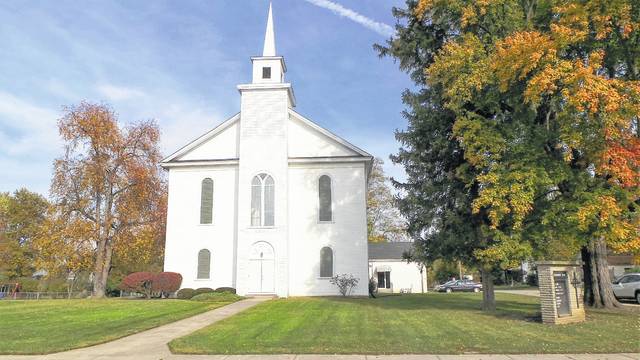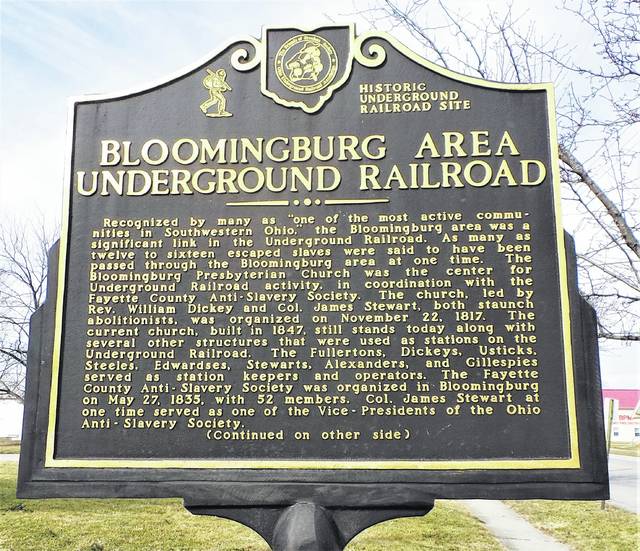

Bloomingburg Presbyterian Church, celebrating its 200th anniversary this year, invites the congregation, former members, pastors and friends to enjoy on Sunday, Sept. 17, 2017, an entertaining, informative afternoon re-dedicating the historic church to its mission since 1817 of serving its faithful and its community.
In the first Record-Herald article of this anniversary-year series, printed on Feb. 4, the following paragraph appeared: “The fledgling church benefited right from the start by sharing a pastor with the Washington C.H. Presbyterians; but after three years of a dual ministry, the Rev. William Dickey decided—for reasons undocumented but suspected (look for a subsequent article about BPC’s Underground Railroad connections)—to concentrate on Bloomingburg….”
So let’s look into the church’s Underground Railroad connections. Deceased local historian Kenneth Craig—father of Washington C.H. dentist Warren Craig and also this writer’s algebra teacher back in 1959-60 at Bloomingburg High School—believed that the controversial anti-slavery issue was the main reason William Dickey ended up serving the Bloomingburg congregation. Dickey had been born in 1774 in South Carolina and educated in both Tennessee and Kentucky; he preached in the latter state for 15 years before coming to Ohio. His father and stepmother, of whom he was very fond, were known to be highly moral people; and during those years living in the South, Dickey developed a strong aversion to slavery.
Evidence of the Rev. William Dickey’s influence on his Bloomingburg congregation—which started him at a salary of $300 per year for three-fourths of his time (with the remaining fourth to be devoted to missionary work among the Indians)—became newly available during a 1998-2001 investigation of the Underground Railroad in Fayette County. This intensive work was done over four years by the Senior Research History classes of social studies teacher Paul LaRue at Washington Senior High School. Although the recipient of numerous state and national teaching awards, LaRue is best known and beloved for his work getting students out into the community using “hands on” history.
These classes concluded that “the Presbyterian church was the most actively involved [in the Underground Railroad] of any denomination in the area.” Staunch abolitionist William Dickey served at Bloomingburg Presbyterian from 1817-57, and during that time many local Underground Railroad station keepers were members of his church. The church also hosted a series of debates that led to the organization in May 1835 of the Fayette County Anti-Slave Society, with 52 members. (One notorious incident occurred when church windows were broken by a pro-slavery mob.)
The village’s location was undoubtedly another factor in Bloomingburg Presbyterian’s Underground Railroad prominence: As the impressive historical marker in front of the town hall mentions, “Bloomingburg is located on the east fork of Paint Creek, a key route that the fugitive slaves followed.”
Thanks to efforts by LaRue and his students, Bloomingburg Presbyterian Church was selected as one of Ohio’s first historic sites to receive a marker flag from the Ohio-based Friends of Freedom Society honoring the church’s Underground Railroad activism. The marker in front of the town hall was also authorized by the Friends of Freedom Society, with financial assistance from Fayette County Travel & Tourism. In addition, the church qualified to be listed in the National Park Service’s “Network to Freedom” database, overseen by the U.S. Department of the Interior.
Fascinated? You can learn more in person: Paul LaRue will give the keynote speech during the church’s re-dedication ceremony on Sept. 17. Having retired in 2014 after 30 years with the Washington C.H. City Schools—during which he received awards ranging from the American Legion Ohio Educator of the Year early on, to the Ohio Civil Rights Commission’s Excellence in Diversity Award during his final year of teaching—he continues to serve on numerous advisory boards, to present at conferences both in Washington D.C. and in neighboring states, and to be honored for his development of teacher resources.



